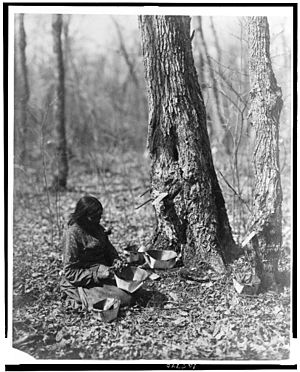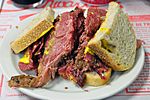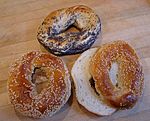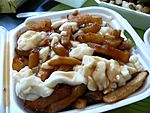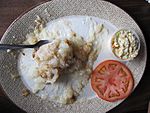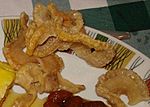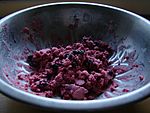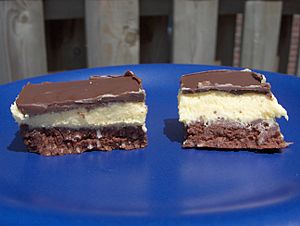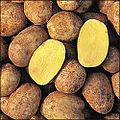Canadian cuisine facts for kids
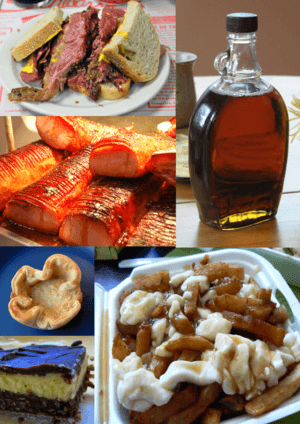
Canadian cuisine varies widely depending on the regions of the nation. The four earliest cuisines of Canada have indigenous, English, Scottish and French roots. The traditional cuisine of English Canada is closely related to British cuisine.
The traditional cuisine of French Canada has evolved from 16th-century French cuisine and the difficult conditions New France colonials and Coureur des bois faced. French Canadian cuisine is also now often divided into Québécois cuisine and Acadian cuisine.
With subsequent waves of immigration in the 19th and 20th centuries from Central, Southern, and Eastern Europe, South Asia, East Asia, and the Caribbean, regional cuisines were affected.
Contents
History
Definitions
Although certain dishes may be identified as "Canadian" due to the ingredients used or the origin of its inception, an overarching style of Canadian cuisine is more difficult to define. Some Canadians such as the former Canadian Prime Minister Joe Clark believe that Canadian cuisine is a collage of dishes from the cuisines of other cultures. Clark himself has been paraphrased to have noted: "Canada has a cuisine of cuisines. Not a stew pot, but a smorgasbord."
While the immense size of Canada and the diversity of its inhabitants compounds the difficulty in identifying a specific Canadian food identity, Hersch Jacobs acknowledges that the lack of a hegemonic definition does not preclude the existence of Canadian cuisine. Lenore Newman argues that there is a distinctly Canadian creole cuisine. She identifies five key properties that together define Canadian cuisine, namely its reliance on seasonality, multiculturalism, wild foods, regional dishes, and the privileging of ingredients over recipes.
Indigenous food in particular is considered very Canadian. Métis food is especially so, since the Métis people played a particularly important role in the origin of Canada and Canadian cuisine. Foods such as bannock, moose, deer, bison, pemmican, maple taffy, and Métis stews such as barley stew are all either traditional Indigenous foods or originated in Canada with roots in Indigenous cuisines, and are eaten widely throughout the country.
Other foods that originated in Canada are often thought of in the same overarching group of Canadian food as Indigenous foods, despite not being so, such as peameal bacon, cajun seasoning, and Nanaimo bars.
There are also some foods of non-Canadian origin that are eaten very frequently. Pierogies (dumplings of Central and Eastern European origin) are an example of this, due to the large number of early Ukrainian and Polish immigrants.
Some regional foods are not eaten as often on one side of the country as on the other, such as dulse in the Maritimes, stews in the Territories, or poutine in the Francophone areas of Canada (not limited to Québec). In general, Canadian foods contain a lot of starch, breads, game meats (such as deer, moose, bison, etc.), and often involve a lot of stews and soups, most notably Métis-style and split-pea soup.
Regional and cultural contributions
Canadian food has been shaped and impacted by those of indigenous people, settlers and immigrants.
Indigenous peoples
The traditional Indigenous cuisine of Canada was based on a mixture of wild game, foraged foods, and farmed agricultural products. Each region of Canada with its own First Nations and Inuit people used their local resources and own food preparation techniques for their cuisines.
Maple syrup was first collected and used by aboriginal people of Eastern Canada and North Eastern US. Canada is the world's largest producer of maple syrup. The origins of maple syrup production are not clear though the first syrups were made by repeatedly freezing the collected maple sap and removing the ice to concentrate the sugar in the remaining sap. Maple syrup is one of the most commonly consumed Canadian foods of Aboriginal origins.
Dried meat products such as pânsâwân and pemmican are commonly consumed by the indigenous peoples of the plains. In particular, the former was a predecessor for North American style beef jerky, with the processing methods adapted for beef.
In most of the Canadian West Coast and Pacific Northwest, Pacific salmon was an important food resource to the First Nations peoples, along with certain marine mammals. Salmon were consumed fresh when spawning or smoked dry to create a jerky-like food that could be stored year-round. The latter food is commonly known and sold as "salmon jerky".
Whipped Soapberry, known as sxusem (sk-HOO-shum, "Indian ice cream") in the Interior Salish languages of British Columbia, is consumed similarly to ice cream or as a cranberry-cocktail-like drink. It is known for being a kidney tonic, which are called agutak in Arctic Canada (with animal/fish fat).
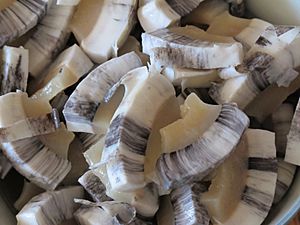
In the Arctic, Inuit traditionally survived on a diet consisting of land and marine mammals, fish, and foraged plant products. Meats were consumed fresh but also often prepared, cached, and allowed to ferment into igunaq or kiviak. These fermented meats have the consistency and smell of certain soft aged cheeses. Snacks such as muktuk, which consist of whale skin and blubber is eaten plain, though sometimes dipped in soy sauce. Chunks of muktuk are sliced with an ulu prior to or during consumption.
Fish are eaten boiled, fried, and prior to today's settlements, often in dried forms. The so-called "Eskimo potato" (Inuit: oak-kuk: Claytonia tuberosa) and other "mousefoods" are some of the plants consumed in the arctic.
Foods such as "bannock", popular with First Nations and Inuit, reflect the historic exchange of these cultures with French fur traders, who brought with them new ingredients and foods. Common contemporary consumption of bannock, powdered milk, and bologna by aboriginal Canadians reflects the legacy of Canadian colonialism in the prohibition of hunting and fishing, and the institutional food rations provided to Indian reserves.
Due to similarities in treatment under colonialism, many Native American communities throughout the continent consume similar food items with some emphasis on local ingredients.
European settlers and European immigrants
Settlers and traders from the British Isles account for the culinary influences of early English Canada in the Maritimes and Southern Ontario (Upper Canada). Southwestern regions of Ontario have strong Dutch and Scandinavian influences.
The French settlers who became the Canadiens and Acadians account for the cuisine of southern Quebec (Lower Canada), Northeastern Ontario, and New Brunswick.
In Canada's Prairie provinces, which saw massive immigration from Eastern and Northern Europe in the pre-WWI era, Ukrainian, German, and Polish cuisines are strong culinary influences. Also noteworthy in some areas of the British Columbia Interior and the Prairies is the cuisine of the Doukhobors, Russian-descended vegetarians.
The Waterloo, Ontario, region and the southern portion of Manitoba have traditions of Mennonite and Germanic cookery.
The cuisines of Newfoundland and the Maritime provinces derive mainly from British and Irish cooking, with a preference for salt-cured fish, beef, and pork. Ontario, Manitoba and British Columbia also maintain strong British cuisine traditions.
Jewish immigrants to Canada during the late 1800s played a significant culinary role within Canada, chiefly renowned for Montreal-style bagels and Montreal-style smoked meat. A regional variation of both emerged within Winnipeg, Manitoba's Jewish community, which also derived Winnipeg-style cheesecake from New York City recipes. Winnipeg has given birth to numerous other unique dishes, such as the schmoo torte, smoked goldeye and "co-op style" rye bread and cream cheese.
Asian immigrants
Much of what are considered "Chinese dishes" in Canada are more likely to be Canadian or North American inventions, with the Chinese restaurants of each region tailoring their traditional cuisine to local tastes. This "Canadian Chinese cuisine" is widespread across the country, with great variation from place to place, from Calgary ginger beef, to Montreal peanut-butter dumplings and Thunder Bay bon bons.
The Chinese buffet, although found in the United States and other parts of Canada, had its origins in early Gastown, Vancouver, c.1870. This serving setup came out of the practice of the many Scandinavians working in the woods and mills around the shantytown getting the Chinese cook to put out a steam table on a sideboard.
Unique Indo-Canadian food includes East Indian roti which gained popularity in Toronto during the 1980s and 1990s; using North Indian/Pakistani bread and curries as stuffing, local chefs originally drew inspiration from the West Indian roti which had entered the city's food scene in the 1960s and 1970s after a wave of Caribbean immigration. Also known as butter chicken roti, the dish is served at many Indian restaurants and fast food locations across Southern Ontario.
Compared to other cultural contributors, South Asia was a very recent influence to Canadian cuisine due to their late prominence in post-1960s immigration era. Indian food is particularly popular in Canada, deriving mostly from Northern Indian cuisine. It is characterized for its use of bread, curry, and use of yogurt and cream for meat-based dishes; it also draws inspiration from South Indian cuisine in its use of sour and spicy combinations.
Contributions from Southeast Asia to Canadian cuisine includes a style of medium-thick crust pizza Margherita in Toronto. An example of fusion cuisine, the pizza is topped with garlic and basil oil topping, combining an Italian pizza with the Vietnamese tradition of using herbed oil toppings in food.
National food of Canada
Foods typically considered national dishes of Canada include poutine and butter tarts.
According to an informal survey by The Globe and Mail conducted through Facebook from collected comments, users considered the following to be the Canadian national dish, with maple syrup likely above all the other foods if it were considered:
- Poutine (51%)
- Montreal-style bagels (14%)
- Salmon jerky (dried smoked salmon) (11%)
- Perogy/Pierogi (10%)
- Ketchup chips (7%)
- Nova Scotian donair (4%)
- California roll (1%)
Canada's most "iconic" foods were named in a survey conducted by the Canadian Broadcasting Corporation, in the summer of 2012, as:
Regional
While many ingredients are commonly found throughout Canada, each region with its own history and local population has unique ingredients, which are used to define unique dishes.
| Ingredient | Defining dish | Pacific | Mountain | The Prairies | Ontario | Quebec | Atlantic | Northern |
|---|---|---|---|---|---|---|---|---|
| Caribou | Caribou stew | X | X | X | ||||
| Potatoes | Poutine | X | X | X | ||||
| Saskatoon berries | Saskatoon berry jam | X | X | X | ||||
| Fiddlehead ferns | Boiled fiddleheads | X | X | X | ||||
| Cloudberry | Bakeapple pie | X | X | |||||
| Maple syrup | Pancake topping | X | X | X | ||||
| Dulse | Dulse crisps | X | ||||||
| Harp seal | Flipper pie | X | X | |||||
| Sockeye | Smoked salmon | X | ||||||
| Pacific salmon | Cedar-plank salmon | X | ||||||
| Atlantic salmon | Smoked salmon | X | X | |||||
| Atlantic cod | Fish and brewis | X | X | |||||
| Lobster | Boiled lobster | X | X | |||||
| Winnipeg goldeye | Smoked goldeye | X | ||||||
| Pork | Farmer sausage | X | ||||||
| Summer savoury | Dressing | X |
Wild game of all sorts is still hunted and eaten by many Canadians, though not commonly in urban centres. Venison, from white-tailed deer, moose, elk (wapiti) or caribou, is eaten across the country and is considered quite important to many First Nations cultures. Seal meat is eaten, particularly in the Canadian North, the Maritimes, and Newfoundland and Labrador. Wild fowl like ducks and geese, grouse (commonly called partridge) and ptarmigan are also regularly hunted. Other animals like bear and beaver may be eaten by dedicated hunters or indigenous people, but are not generally consumed by much of the population.
West Coast salmon varieties include sockeye, coho, Tyee (also known as Chinook or king), and pink. Freshwater fish, such as the walleye (also known as pickerel) and lake whitefish are commercially fished in the Great Lakes and are popular in southern Ontario. Both wild-caught and farmed rainbow trout are consumed throughout Canada.
Wild chanterelle, pine, morel, lobster, puffball, and other mushrooms are commonly consumed. Canada produces good cheeses and many successful beers, and is known for its excellent ice wines and ice ciders. Gooseberries, salmonberries, pearberries, cranberries and strawberries are gathered wild or grown.
Canadian foods
The following are selections of the most prominent Canadian foods.
Savoury foods
Although there are considerable overlaps between Canadian food and the rest of the cuisine in North America, many unique dishes (or versions of certain dishes) are found and available only in the country. Some are more commonly eaten than others.
| Dish | Description | Pacific | Mountain | The Prairies | Ontario | Quebec | Atlantic | Northern |
|---|---|---|---|---|---|---|---|---|
| Calgary-style ginger beef | Candied and deep fried beef, with sweet ginger sauce. | X | O | X | ||||
| Roast beef with Yorkshire pudding | Traditionally a common Sunday dinner among Canadians of British ancestry | X | X | X | X | X | X | |
| Roast turkey | North American roast turkey | X | X | X | X | X | X | |
| Baked beans | Beans cooked with maple syrup | X | X | X | X | X | X | |
| B.C. roll | A variety of sushi containing salmon | O | X | X | ||||
| California roll | A variety of sushi | O | X | X | X | |||
| Dynamite roll | A variety of sushi typically containing prawn tempura | O | X | X | X | |||
| Sushi pizza | Fusion sushi dish with fried rice patty as base, with sushi ingredients on top | X | X | X | O | X | X | |
| Jiggs dinner | A Sunday meal similar to the New England boiled dinner | O | ||||||
| Back or peameal bacon | Bacon that includes the pork loin from the back of the pig | X | X | X | O | X | ||
| Tourtière | A meat pie made of pork and lard | X | X | X | X | O | X | |
| Montreal-style smoked meat | Deli style cured beef | X | X | X | O | X | ||
| Bannock | A fried bread and dough food | X | X | X | X | X | X | |
| Bouilli | Québécois beef and vegetable potroast | O | ||||||
| Bologna stew | A stew made of cubed chunks of Bologna sausage | O | ||||||
| Cod tongues and scrunchions | Baked cod tongue and deep fried pork fat | O | ||||||
| Yellow pea soup | Split pea soup eaten by settlers such as the Habitant | X | X | O | X | |||
| Poutine | A dish of fries topped with cheese curds and gravy | X | X | X | X | O | X | X |
| Montreal-style bagels | A sweet, firm, wood-fired bagel | X | O | |||||
| Pemmican | Ground dried meat, fat, and berries | X | X | |||||
| Oka cheese | Cheese originally manufactured by Trappist monks | X | X | O | ||||
| Flipper pie | Pie made with harp seal flipper | O | ||||||
| Hot chicken sandwich | Chicken (or turkey) sandwich doused in gravy and peas | X | X | X | X | X | ||
| Toutons | Fried bread from Newfoundland | O | ||||||
| Fish and brewis | Salt cod and hardtack, with pork cracklings | O | ||||||
| Rappie pie | Grated potato and meat casserole | O | ||||||
| Cretons | Pork spread containing onions and spices | X | O | |||||
| Poutine râpée | Grated Acadian stuffed potato dumpling | O | ||||||
| Nova Scotian donair | Ground beef doner kebab served with a sweet milk sauce | X | X | X | O | |||
| Garlic fingers | Dough with cheese, garlic, and sometimes meat on top, similar to pizza | X | X | X | X | O | ||
| Lobster roll | Lobster meat mixed with mayonnaise and served in a toasted hot dog bun | X | X | O | ||||
| Cipaille/sea-pie | Fish and meat layered in a pie | X | O | X | ||||
| Pictou County pizza | Regional pizza variant from Nova Scotia with its unique sauce | O |
-
Inuit bannock fried bread
-
Montreal smoked meat sandwich
-
Fish and brewis: salted cod and hard tack
-
Canadian peameal bacon
-
Poutine is made with french fries, curds and gravy
-
Oreilles de crisse: deep fried pork skin and fat
-
Arctic berries Sxusem
Sweets
- Beaver tails—also known as elephant ears, moose antlers, dog ears, whale tails, or simply fried dough.
- Bumbleberry pie—bumbleberry is a mixture of fruit, berries, and rhubarb.
- Butter tarts—said to be invented in Eastern Ontario around 1915. The main ingredients for the filling include butter, sugar and eggs, but raisins and pecans are often added for additional flavour.
- Candy apple—also known by the British term "toffee apple", candied apples are far more popular than in the United States, where the caramel apple is common.
- Cinnamon buns (known as Cinnamon roll outside of Canada).
- Date square, aka Date Crumblies aka Matrimonial cake—date filled desserts.
- Figgy duff—a pudding from Newfoundland.
- Jam busters—prairie jelly doughnuts.
- Flapper pie—wafer pie in Manitoba; a custard pie popular in Western Canada.
- Grandpères—dough dumplings boiled in maple syrup.
- Maple syrup — especially tire d'érable sur la neige or "maple toffee", also as flavouring, for example in maple leaf cream cookies.
- Maple taffy —a sugar candy made by pouring hot maple sap onto snow.
- Moosehunters—molasses cookies.
- Nanaimo bars—most common in British Columbia.
- Nougabricot—a Québécois preserve consisting of apricots, almonds, and pistachios.
- Persians—somewhat like a cross between a large cinnamon bun and a doughnut, topped with strawberry icing, unique to Thunder Bay, Ontario.
- Pets de sœurs—"nuns’ farts", pastry dough wrapped around a brown sugar and butter filling.
- Pouding chômeur—poor man’s pudding.
- Saskatoonberry pie—pie made from saskatoonberries.
- Sucre à la crème—Québécois sweet milk squares.
- Sugar pie—"tarte au sucre", Québécois pie based on a French dessert
Commercially prepared food and beverages
- Canadian pizza—typically includes tomato sauce, mozzarella cheese, bacon, pepperoni, and mushrooms; variations exist. The recipe is also known internationally by this name. The classic preparation, however, is often referred to in the province of Quebec as pizza québécoise.
- Candy
- Bridge mixture (bridge mix)
- Chocolate bars: Coffee Crisp, Mr. Big, Caramilk, Big Turk, Cherry Blossom, Crunchie, Crispy Crunch, Aero, Pal-o-mine, Eat-more Chocolate bar, Canadian Smarties.
- Glosette pieces (peanut, raisin, or almonds)
- Baby food
- Cereal
- Red River Cereal
- Shreddies
- Vector
- Coffee—Canada is the 10th-highest coffee consumer, per capita, in the world.
- Nabob Coffee
- Second Cup Coffee
- Tim Hortons
- Cows ice cream
- Honey dill sauce
- Kraft Dinner (also a proprietary eponym)
- Non-alcoholic drinks
- Bagged milk
- Brio chinotto
- Canada Dry ginger ale
- London Fog
- Red Rose Tea
- Spruce beer—bière d'épinette, non-alcoholic soft drink from Quebec
- Snacks
- Ketchup, salt and vinegar, dill pickle, and "all dressed" flavoured potato chips
- Hawkins Cheezies
- Hostess Potato Chips
- Ringolos and Humpty Dumpty Party Mix
- Nuts and Bolts aka Chex Mix
- Tiger tail ice cream—black licorice- and orange-flavoured ice cream, once popular throughout Canada
Street food
While most major cities in Canada (including Montreal, in a pilot project) offer a variety of street food, regional "specialties" are notable. While poutine is available in most of the country, it is far more common in Quebec.
Similarly, sausage stands can be found across Canada, but are far more common in Ontario (often sold from mobile canteen trucks, usually referred to as "fry trucks" or "chip trucks" and the sausages "street meat").
In Western Canada, a version of the Ukrainian garlic-pork sausage, referred to as "Kubasa" (a corruption of the Ukrainian sausage "Kobasa") is widely available and celebrated. The term "smokies" or "smokeys" may refer to Kubasa rather than frankfurters.
Fusion cultural foods are constantly evolving, such as the Japadog, which tops a hot dog with traditional Japanese ingredients such as wasabi, teriyaki, shredded daikon radish, or bonito (fish) flakes.
Each Canadian region has street specialties which reflect regional cultural influences. Montreal food trucks offer shish taouk, the Montreal hot dog, and dollar falafels. Although falafel is available in Vancouver, Asian-influenced offerings are much more widespread including sushi, samosas, Vietnamese banh mi subs or Pho soup, Filipino offerings, and various Japanese and Chinese cuisines. In Victoria, British Columbia, vegan and vegetarian burgers are on offer, as are various seafood take-aways and Mexican influenced street food.
Pizza slices are a common street offering. Shawarma is quite prevalent in Ottawa and Windsor, while Halifax offers its own unique version of the döner kebab called the donair, which features a distinctive sauce made from condensed milk, sugar, garlic and vinegar.
Ice cream trucks can be seen (and often heard due to a jingle being broadcast on loudspeakers) nationwide during the summer months. Winnipeg has a famous line up of food truck vendors on Main street. Since 2007, the city of Toronto has encouraged vendors to sell street food from a wider variety of cuisines.
Meal formats
- Chinese smorgasbord (see #East Asian)
- Lumberjack's breakfast, aka logger's breakfast, aka "The Lumby"—a gargantuan breakfast of three-plus eggs, rations of ham, bacon and sausages, and several large pancakes.
This was invented by hotelier J. Houston c.1870, at his Granville Hotel on Water Street in old pre-railway Gastown, Vancouver, in response to requests from his clientele for a better "feed" at the start of a long, hard day of work.
Images for kids
-
Canadian pancake breakfast in Calgary
-
Oatcakes were first brought to Atlantic Canada by Scottish Highlanders in 1773, and remain a staple of Halifax coffee shops.
-
Wild turkeys in Ottawa
-
Canadians taking tea at a picnic beside the Bay of Quinte, Prince Edward County (1909 August)
-
Loaf of Ukrainian rye bread from New Westminster
-
Sai Woo restaurant and heritage building in Vancouver Chinatown
-
Kedgeree, an Anglo-Indian dish imported from the British Raj, is commonly found in Indo-Canadian restaurants.
-
Balderson "Royal Canadian Cheddar". Canadian cheddar is a particularly smooth and creamy cheddar cheese that holds a balance between flavour and sharpness.
-
Oka cheese was originally manufactured in the Trappists monasteries of Oka, Quebec and Holland, Manitoba
-
Coffee from Pronto Café in Vancouver. Canada is the 10th largest consumer of coffee in the world, consuming more coffee per capita than any other English-speaking country.
-
The annual pancake breakfast at the Chinook Centre in Calgary feeds over 60,000 in one day.
-
The "Aurora Golden Gala" was created in Summerland, British Columbia at the Pacific Agri-Food Research Centre
-
The "Speckle Park" breed of beef cattle was developed in Saskatchewan by cross-breeding the Aberdeen Angus and Shorthorn. The "speckled" pattern for which it is named is derived from a single progenitor bull with the colour-pointed markings of the White Park.
-
The "Stella cherry" is the first self-fertile sweet cherry to be named and was awarded the Award of Garden Merit by the Royal Horticultural Society.
-
The "Yukon Gold" potato was developed at the University of Guelph
-
"Red Fife" wheat is named after the colour of its kernel and the Peterborough farmer who developed it, Dave Fife.
-
Tourtière from Granville Island Public Market
See also
 In Spanish: Gastronomía de Canadá para niños
In Spanish: Gastronomía de Canadá para niños


